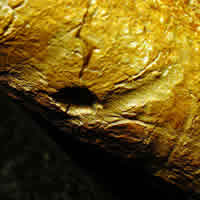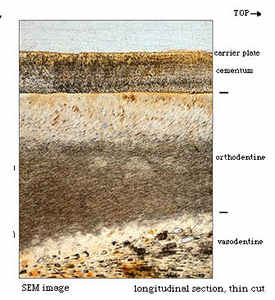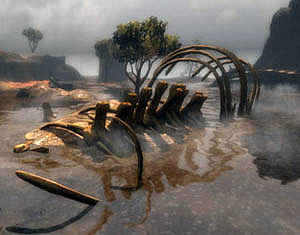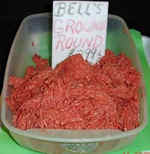Even in the frenzy of the blood and the pain, the snarling and dying at a kill site there is a choreography that has evolved to share the spoils and reduce conflict. The patterns that predators leave behind often provide clues pointing to their identity–even if the site is 12,000 years old and absent distinctive tooth marks. Gary Hanes has spent years studying the kill sites of various predators and his research provides a general picture of their different patterns.
According to Haynes (1988) every wolf pack has its hierarchy and once the prey is dead, and often even before, the process of staking out claims on preferred cuts and dividing the carcass begins. The dominant wolf will take the choice position. The blood and internal organs inside the abdomen are a favorite first pick. Sternal elements and ribs are usually damaged in the process. Other high ranking wolves will claim the rump and upper legs where there are large masses of flesh. If there are more animals in the pack than can comfortably situate themselves around the carcass to eat without invading each other’s space, they’ll start disarticulating the limbs, causing distinctive damage on the proximal ends of the femora and humeri , and their anchoring points on the pelvis and scapulae. The prizes will be carried a short distance away to be gnawed on in relative solitude. Lower ranking wolves will tear off smaller less desirable parts (e.g. ears, tail, jaw/tongue) and carry them further away. These satellite consumption spots will be randomly distributed around the carcass and about 20 feet apart (Haynes, ibid.). Tooth marks and distance will be correlated as wolves lower in the pecking order tend to invest more time gnawing on their meager rations instead of trying to muscle in and steal another portion.

 Did predators killed the sloths?
Did predators killed the sloths? How big is our adult sloth? Greg McDonald says the average adult Megalonyx weighed 2,400 pounds (McDonald, 2005). That’s based on a standard formula used to approximate the weight of mammals based on measurements of their femurs, and engineering principles relating the strength of a column to its cross-sectional area. I’m a little dubious about applying the formula to sloths though. There’s nothing normal about the shape of most of their bones. Even a simple measurement like the femur’s diameter isn’t straightforward. Add a lingering uncertainty about sloth locomotion and lifestyle (bipedal vs. quadrupedal), and any weight estimate has to taken with a grain of salt. But, as Greg once told me, you have to start somewhere, and why not with the bone used in all the other mammals, and a bone that’s been recovered often enough to provide a reasonably-sized sample. If you stick to femurs, at least you can compare sloth weights in relative terms. We’ve recovered an adult femur and you’ll see a weight estimate when Meghann, our resident anatomy expert, is sure we’re measuring it from the right anatomical points.
How big is our adult sloth? Greg McDonald says the average adult Megalonyx weighed 2,400 pounds (McDonald, 2005). That’s based on a standard formula used to approximate the weight of mammals based on measurements of their femurs, and engineering principles relating the strength of a column to its cross-sectional area. I’m a little dubious about applying the formula to sloths though. There’s nothing normal about the shape of most of their bones. Even a simple measurement like the femur’s diameter isn’t straightforward. Add a lingering uncertainty about sloth locomotion and lifestyle (bipedal vs. quadrupedal), and any weight estimate has to taken with a grain of salt. But, as Greg once told me, you have to start somewhere, and why not with the bone used in all the other mammals, and a bone that’s been recovered often enough to provide a reasonably-sized sample. If you stick to femurs, at least you can compare sloth weights in relative terms. We’ve recovered an adult femur and you’ll see a weight estimate when Meghann, our resident anatomy expert, is sure we’re measuring it from the right anatomical points.

 I cited Swedish explorer Erland Nordenskiold in a
I cited Swedish explorer Erland Nordenskiold in a  Shipman (1981) states that only 1% of the terrestrial animals that die are preserved. This average however disguises the heavy bias in the fossil record in favor of species from lowland habitats (ponds, marshes, floodplains, etc.) where sediments accumulate and provide a protective blanket for the remains. Rapid burial is a critical factor improving the probability of preservation. Burial reduces physical weathering and reduces the opportunity for scavengers to damage and scatter the bones. Also, the more rapidly a specimen is covered, the poorer the environment for some destructive microbes. Most of the Earth’s continental surface is upland, but the preservation environment here is relatively poor.
Shipman (1981) states that only 1% of the terrestrial animals that die are preserved. This average however disguises the heavy bias in the fossil record in favor of species from lowland habitats (ponds, marshes, floodplains, etc.) where sediments accumulate and provide a protective blanket for the remains. Rapid burial is a critical factor improving the probability of preservation. Burial reduces physical weathering and reduces the opportunity for scavengers to damage and scatter the bones. Also, the more rapidly a specimen is covered, the poorer the environment for some destructive microbes. Most of the Earth’s continental surface is upland, but the preservation environment here is relatively poor. Hamburger doesn’t fight bac
Hamburger doesn’t fight bac